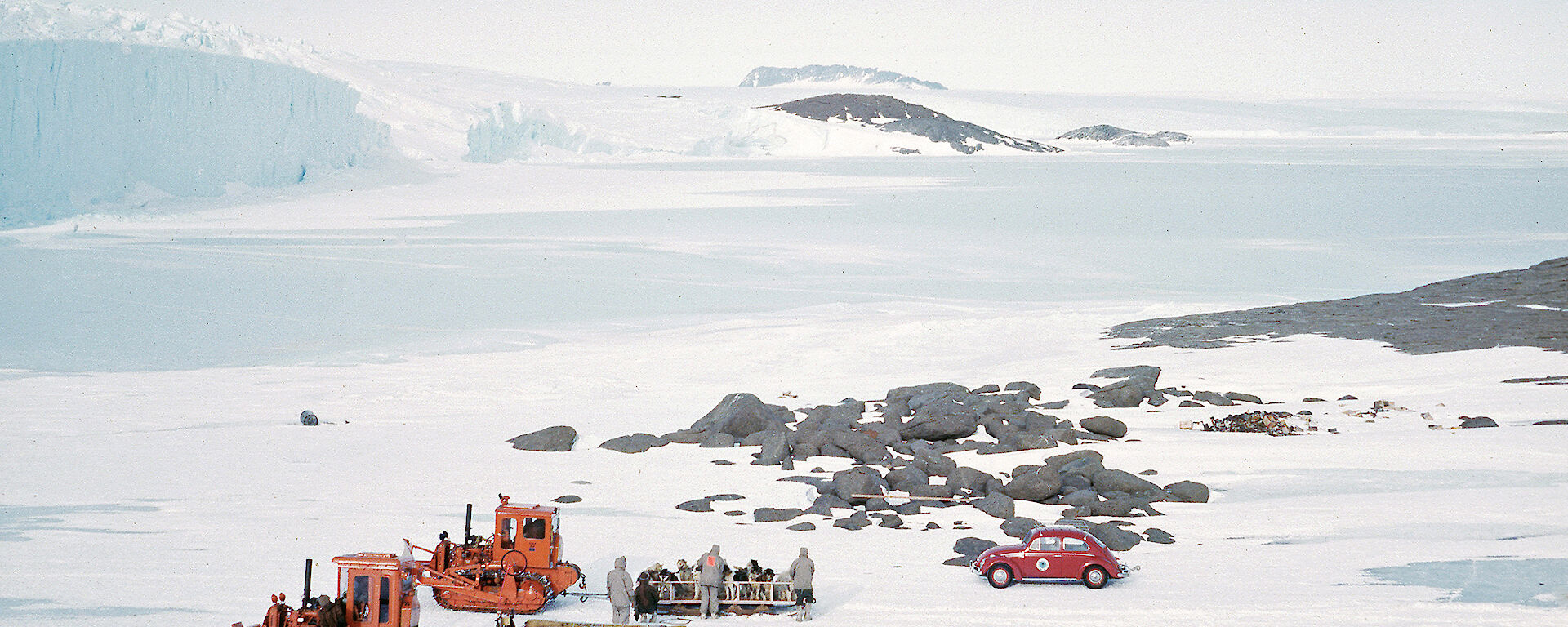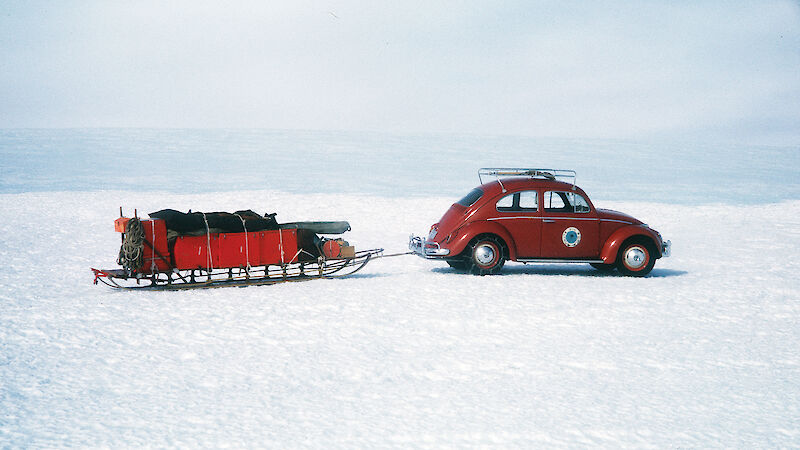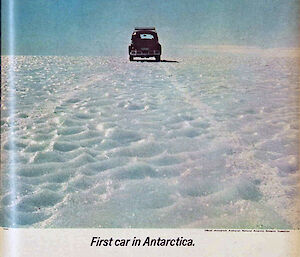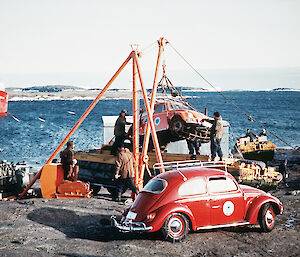The Editor at the Volkswagen Club in Sydney, Phil Matthews, recently completed a history of the Volkswagen ‘Beetles’ that served at Mawson station between 1963 and 1970. The following is an edited extract from The Antarctic VWs, an expanded version of a story that originally appeared in his book Knowing Australian Volkswagens (Bookworks 1993). The full story of the Ruby-Red Beetle, Antarctica 1, and two orange vehicles — Antarctica 2 and 3 — can be read at Club VeeDub.
In 1962, the Australian National Antarctic Research Expeditions (ANARE) was looking for cheap motorised transportation to complement the heavy tracked vehicles at Mawson. Transport at Mawson was normally provided by tracked vehicles, dog sleighs and motorbikes. But all these had their limits. The motorbikes could only transport small loads. The tractors could run at a maximum speed of 5km/h and used too much fuel. The dog teams needed to have been in harness for a long time, required continual care and could only be managed by someone experienced in their handling.
In November 1962, the incoming 1963 expedition leader was a young engineering draughtsman named Ray McMahon. While he was making preparations at ANARE Head Office in Melbourne, he read that there were a couple of water-cooled vehicles at Mawson; a Ferguson tractor and a flat topped Bedford truck. He reckoned if they were being used successfully around the station, then why wouldn’t an air cooled VW be suitable for some ‘around the station’ functions? Using his initiative, he picked up the phone and rang the marketing office of Volkswagen Australasia at Clayton. Ray spoke with a cadet marketing person by the name of Graham Massingham. Ray asked him if VWA would be cooperative and loan ANARE a VW to take to Mawson for the year.
It just so happened that the Volkswagenwerk Head Office in Germany had recently been encouraging their subsidiaries around the world to concentrate their marketing efforts on publicising VW service in Arctic conditions. Young Graham scored the promotional coup of his life, and the opportunity to send a VW to Mawson was enthusiastically welcomed by his superiors.
Ray was invited to Clayton, and an Australian-made Ruby-Red 1962½ model Beetle was selected at random from a batch made in December 1962. The Ruby-Red colour was chosen so the car would stand out from the snowscape.
The Clayton Service Workshop then gave the Beetle a thorough ‘winterising’, a northern European process unknown in hot Australia. The engine was rebuilt with special European ‘winter’ quality crankshaft bearings for extreme service low-temperature conditions, such as those in Norway and Finland. The exhaust manifolds were wrapped in asbestos insulation to assist initial warm-up. The front wheel bearings and torsion bars were lubricated with winter-spec lithium grease. The VW was fitted with a pair of heavy-duty six-volt batteries in series, so that starting could be achieved at 12 volts through the 6-volt starter motor, but the rest of the electrical system remained 6-volt. A rear tow bar and sump guard was fitted, and a factory storage rack was bolted to the roof.
Official VW preparation was very thorough. The car was delivered with a box of general spare parts and spare wheels, as well as a quality Bolex cine camera with a generous stock of movie film. Large ANARE labels were painted on the doors, and special aluminium ‘ANTARCTICA 1’ number plates were made and mounted front and rear. Volkswagen Australasia covered the costs of the vehicle and all spares and modifications.
After collection and inspection by Ray McMahon, the VW was loaded aboard the supply ship Nella Dan at Port Melbourne, and shipped 6100km south to Mawson. It was unloaded with the normal year’s supplies in January 1963. The engineers filled the petrol tank with BP winter-grade petrol, which proved perfectly suitable for the local conditions.
The VW underwent some initial trial runs, including a 35km round-trip to the inland Rumdoodle airstrip up on the ice plateau. The VW made the run in 65 minutes, a near record. There is a very steep snow slope behind Mawson, which must be climbed to reach the plateau. Many doubters — including even the Captain of the Nella Dan – bet Ray McMahon that the Volkswagen wouldn’t make it under its own power. It did.
ANARE official photographer Geoff Merrill took a number of photos of the VW at Mawson, at the airstrip at Rumdoodle, and in several stunning nearby locations that showed the beauty of the Antarctic area. He also shot the first 500 feet of movie film, which returned to Hobart aboard the Nella Dan. These first photos caused a sensation, and were used in a string of VW ads and promotions.
The VW spent a whole year at Mawson, competing with dog teams, Polaris medium over snow vehicles and larger tracked vehicles such as the Weasels, Caterpillars and Porsche 356-engined Snowtracs. Subjected to smothering snows, bitter cold down to −50°C and knifing 200km/h winds, it turned out to be excellent for running around the station and short traverses of the ice-bound country. It even went up snow-covered hills which were difficult to climb on foot because of the sinking snow. Being air-cooled it never froze, and being tightly sealed it was immune from drifting powder snow, which at Mawson was so fine that it could blow through pin holes.
Scientists soon fell in love with the VW and christened it their ‘Red Terror’, but it was officially known as Antarctica 1. VW Australia proudly called it ‘the first production car to visit Antarctica’. It was used for a multitude of purposes and within its limitations proved extremely useful, according to ANARE people who used it. With snow chains on all four wheels, it could be used for everything from transporting supplies out to field teams, to towing skiers around the base, to taxiing VIPs to and from the airfield at Rumdoodle, to driving glaciologists three or four kilometres out onto the sea ice to test its thickness.
While Antarctica 1 performed admirably, the brutal treatment it received over its year in the ice did reveal one major weakness — the chassis frame head, where the two transverse front suspension tubes mounted to the frame. Although it’s not an unknown weakness in VW Beetle construction, it almost never showed up in a lifetime of normal use for most cars. In Antarctica the cracking could be induced in only a few hundred miles, thanks to the punishing conditions and extremely low temperatures. Antarctica 1 suffered frame head cracking only a month or two after it arrived, thanks to assorted heavy hands and leaden feet. Then again, on washboard-like corrugated ice thousands of years old, and driving over ice cracks ten or twenty centimetres across and bottoming the suspension constantly under full loads of men and equipment in temperatures dozens of degrees below zero, what wouldn’t fail in such conditions? The Mawson mechanical workshops soon learnt to diagnose the problem and were always on hand for a welding repair job.
When the 1964 expedition team arrived they brought with them Antarctica 1’s replacement — another Volkswagen called Antarctica 2. The new car was also an Australian-made Beetle; a 1963 model painted International Orange. It was fitted out in the same winterised manner, complete with ANARE labels on the doors and special ‘Antarctica 2’ number plates. It also had the benefit of additional bracing of the front axle to reduce the frame head problem. The orange car was unloaded at Mawson to begin its term of service, and briefly the two Antarctic VWs stood side by side at the docks for the first and only time, before Antarctica 1 was loaded onto the Nella Dan for the journey home.
The cine camera was used to make a fascinating short general interest 16mm film called Antarctica 1. There is an original 16mm copy in the National Library of Australia’s collection. A shorter edited version called Taxi to Rumdoodle was also released and is currently available on DVD from the Club Veedub Sydney library.
Phil Matthews
Volkswagen Club, Sydney





